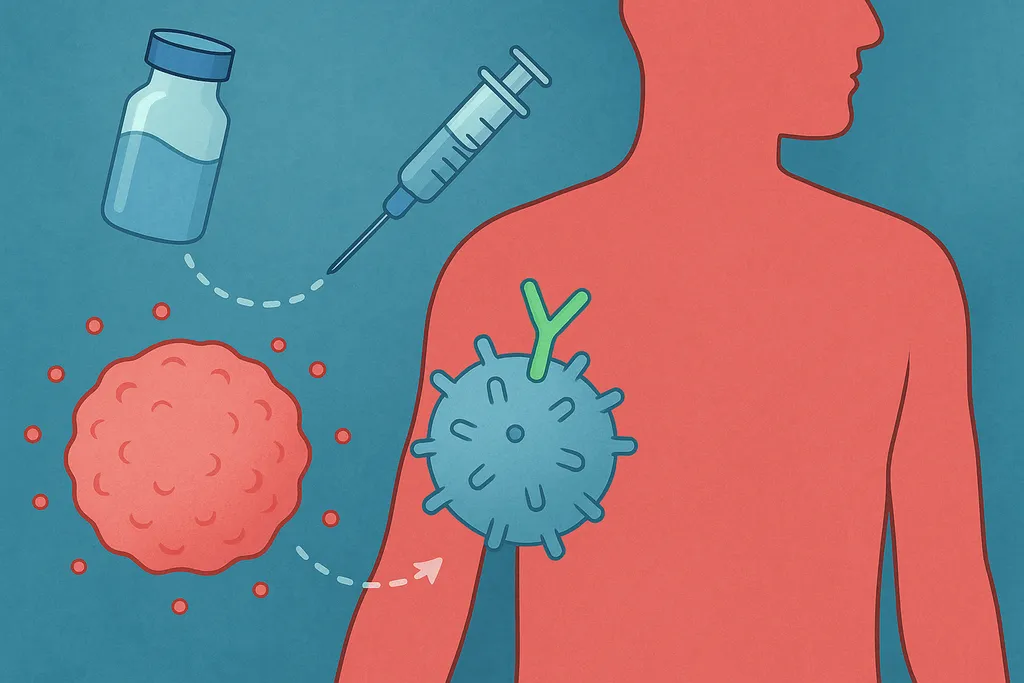Making CAR-T Therapy Safer and More Accessible for DLBCL Patients

Diffuse large B-cell lymphoma (DLBCL) is a type of non-Hodgkin lymphoma, a cancer that affects the white blood cells. While CAR-T therapy has shown remarkable success in treating DLBCL, the current mandatory monitoring period after treatment can be burdensome for patients.
Recent studies offer promising news for DLBCL patients considering CAR-T therapy. These studies suggest that the mandatory monitoring period after CAR-T treatment might be shorter than currently required, potentially reducing the financial and emotional strain on patients and their families and improving accessibility to these novel therapies.
What is CAR-T Therapy?
CAR T-cell therapy involves modifying a patient's T-cells (a type of immune cell) to better fight cancer. This therapy has achieved high response rates and durable remissions in DLBCL patients who stopped responding to treatment or those whose cancer came back after a period of time without it.
The currently approved CAR-T cell therapies for treating DLBCL are:
- Axicabtagene ciloleucel (axi-cel)
- Tisagenlecleucel (tisa-cel)
- Lisocabtagene maraleucel (liso-cel)
To learn more about CAR T-cell therapies for treating DLBCL, watch our previous webinar, ‘CAR T-Cell Therapy Advances in Large B Cell Lymphoma’.
Why is Monitoring Important After CAR-T Infusion?
Although they are very effective, these CAR-T therapies can cause serious side effects that require close monitoring, such as:
- Cytokine release syndrome (CRS); cytokines are proteins that dictate the immune system response, inflammation and cell activation, when released, they can cause fever, low blood pressure, and difficulty breathing, or in rare cases, a severe or life-threatening reaction.
- Immune effector cell-associated neurotoxicity syndrome (ICANS) can lead to confusion, seizures, and even loss of consciousness. It is diagnosed after thorough examination and questioning, and most cases resolve without treatment, but some require supportive care and early intervention with corticosteroids.
To manage the side effect risks, the U.S. Food and Drug Administration (FDA) requires patients to stay close to their treatment centers for four weeks and avoid driving for eight weeks after treatment. This can be difficult for patients who live far from specialized treatment centers.
Dr. Nausheen Ahmed from the University of Kansas Medical Center explains;
"Many of my patients travel six to eight hours for treatment. The current monitoring requirements are a significant barrier for them."
Could the Post-Infusion CAR-T Monitoring Period be Safely Shortened?
A recent study of 475 patients across nine treatment centers found that CRS and ICANS mostly occur within the first two weeks after treatment. From Day 12 after treatment, no new cases of CRS were reported, and only one patient experienced ICANS. If confirmed in larger studies, these results would change how side effects are monitored, shortening the strict four-week monitoring period to only two weeks.
While these studies provide promising data, it's important to note that the optimal monitoring duration may vary for each patient. Some might need an extended monitoring depending on the lymphoma’s severity, their overall health, and the specific CAR-T therapy received.
The essential role of local oncologists
Some late neurological side effects and serious infections can still happen weeks or months after the CAR-T infusion. Therefore, to safely reduce the 4-week intensive monitoring to 2-weeks, it is key that community doctors are trained in recognizing and managing potential late side effects. Clear protocols would need to be established for when and how to escalate care back to the specialized treatment centers if severe side effects occur.
Benefits of a Shorter Monitoring Period for Patients
Dr. Ahmed believes this could significantly improve accessibility, especially for patients from minority and low-income backgrounds who face greater challenges in time and travel costs. A shorter monitoring period could offer several advantages for all DLBCL patients who are considering CAR T-cell therapy, including:
- Better access: Patients who live far from a specialized treatment center may have greater access to CAR-T therapy.
- Reduced financial burden: A shorter monitoring period could alleviate the financial strain associated with extended stays away from home and work.
- Improved quality of life: Patients may experience less stress and disruption to their daily lives.
This study offers hope for a more flexible approach to monitoring CAR-T therapy side effects, potentially making it easier for patients to access and benefit from these treatments. As the medical community continues to learn and adapt, the ultimate goal remains clear: to provide safe, effective, and accessible care for all patients.
With HealthTree you can stay informed with comprehensive DLBCL updates by joining our newsletter!
Sources:
Diffuse large B-cell lymphoma (DLBCL) is a type of non-Hodgkin lymphoma, a cancer that affects the white blood cells. While CAR-T therapy has shown remarkable success in treating DLBCL, the current mandatory monitoring period after treatment can be burdensome for patients.
Recent studies offer promising news for DLBCL patients considering CAR-T therapy. These studies suggest that the mandatory monitoring period after CAR-T treatment might be shorter than currently required, potentially reducing the financial and emotional strain on patients and their families and improving accessibility to these novel therapies.
What is CAR-T Therapy?
CAR T-cell therapy involves modifying a patient's T-cells (a type of immune cell) to better fight cancer. This therapy has achieved high response rates and durable remissions in DLBCL patients who stopped responding to treatment or those whose cancer came back after a period of time without it.
The currently approved CAR-T cell therapies for treating DLBCL are:
- Axicabtagene ciloleucel (axi-cel)
- Tisagenlecleucel (tisa-cel)
- Lisocabtagene maraleucel (liso-cel)
To learn more about CAR T-cell therapies for treating DLBCL, watch our previous webinar, ‘CAR T-Cell Therapy Advances in Large B Cell Lymphoma’.
Why is Monitoring Important After CAR-T Infusion?
Although they are very effective, these CAR-T therapies can cause serious side effects that require close monitoring, such as:
- Cytokine release syndrome (CRS); cytokines are proteins that dictate the immune system response, inflammation and cell activation, when released, they can cause fever, low blood pressure, and difficulty breathing, or in rare cases, a severe or life-threatening reaction.
- Immune effector cell-associated neurotoxicity syndrome (ICANS) can lead to confusion, seizures, and even loss of consciousness. It is diagnosed after thorough examination and questioning, and most cases resolve without treatment, but some require supportive care and early intervention with corticosteroids.
To manage the side effect risks, the U.S. Food and Drug Administration (FDA) requires patients to stay close to their treatment centers for four weeks and avoid driving for eight weeks after treatment. This can be difficult for patients who live far from specialized treatment centers.
Dr. Nausheen Ahmed from the University of Kansas Medical Center explains;
"Many of my patients travel six to eight hours for treatment. The current monitoring requirements are a significant barrier for them."
Could the Post-Infusion CAR-T Monitoring Period be Safely Shortened?
A recent study of 475 patients across nine treatment centers found that CRS and ICANS mostly occur within the first two weeks after treatment. From Day 12 after treatment, no new cases of CRS were reported, and only one patient experienced ICANS. If confirmed in larger studies, these results would change how side effects are monitored, shortening the strict four-week monitoring period to only two weeks.
While these studies provide promising data, it's important to note that the optimal monitoring duration may vary for each patient. Some might need an extended monitoring depending on the lymphoma’s severity, their overall health, and the specific CAR-T therapy received.
The essential role of local oncologists
Some late neurological side effects and serious infections can still happen weeks or months after the CAR-T infusion. Therefore, to safely reduce the 4-week intensive monitoring to 2-weeks, it is key that community doctors are trained in recognizing and managing potential late side effects. Clear protocols would need to be established for when and how to escalate care back to the specialized treatment centers if severe side effects occur.
Benefits of a Shorter Monitoring Period for Patients
Dr. Ahmed believes this could significantly improve accessibility, especially for patients from minority and low-income backgrounds who face greater challenges in time and travel costs. A shorter monitoring period could offer several advantages for all DLBCL patients who are considering CAR T-cell therapy, including:
- Better access: Patients who live far from a specialized treatment center may have greater access to CAR-T therapy.
- Reduced financial burden: A shorter monitoring period could alleviate the financial strain associated with extended stays away from home and work.
- Improved quality of life: Patients may experience less stress and disruption to their daily lives.
This study offers hope for a more flexible approach to monitoring CAR-T therapy side effects, potentially making it easier for patients to access and benefit from these treatments. As the medical community continues to learn and adapt, the ultimate goal remains clear: to provide safe, effective, and accessible care for all patients.
With HealthTree you can stay informed with comprehensive DLBCL updates by joining our newsletter!
Sources:

about the author
Jimena Vicencio
Jimena is an International Medical Graduate and a member of the HealthTree Writing team. Currently pursuing a bachelor's degree in journalism, she combines her medical background with a storyteller’s heart to make complex healthcare topics accessible to everyone. Driven by a deep belief that understanding health is a universal right, she is committed to translating scientific and medical knowledge into clear, compassionate language that empowers individuals to take control of their well-being.
More on Treatment Advances
Trending Articles
Get the Latest Large B Cell Lymphoma Updates, Delivered to You.
By subscribing to the HealthTree newsletter, you'll receive the latest research, treatment updates, and expert insights to help you navigate your health.
Together we care.
Together we cure.
3x Faster.










